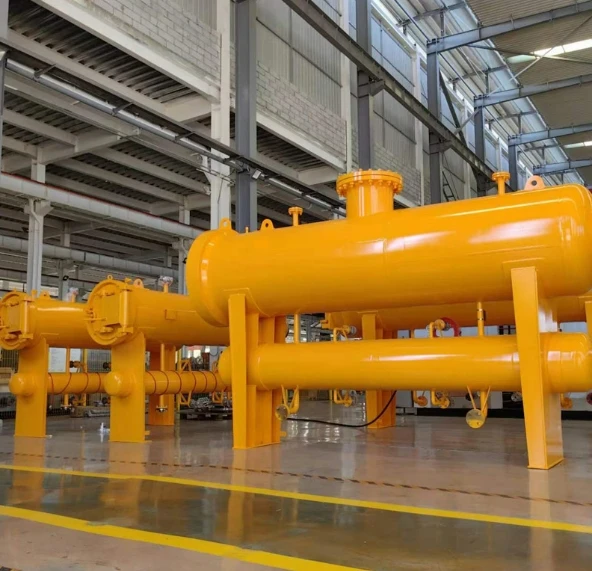
Dec . 11, 2024 12:07
Back to list
lpg equipment
Understanding LPG Equipment Essential for Efficient Energy Use
Liquefied Petroleum Gas (LPG) is a widely utilized energy source, known for its efficiency in heating, cooking, and fueling vehicles. LPG equipment refers to the various tools and devices used in the storage, transportation, and utilization of liquefied petroleum gas. This article provides an overview of the types of LPG equipment, their applications, and their importance in different industries.
Types of LPG Equipment
1. Storage Tanks LPG is typically stored in specialized tanks designed to handle its high-pressure and temperatures. These storage tanks can be stationary or mobile, with fixed or semi-buried configurations. The design of these tanks complies with strict safety and regulatory standards to prevent leaks and ensure safety.
2. Pressure Regulators A crucial component of any LPG system, pressure regulators control the flow of gas from the storage tank to the appliances. They ensure that the gas pressure remains stable, providing a safe and reliable gas supply for various applications.
3. Piping Systems LPG is distributed through a network of pipes designed to handle its unique properties. These pipes must be made from materials that can withstand high pressure and are resistant to corrosion. Proper installation and maintenance of piping systems are critical to prevent leaks and ensure efficient gas flow.
4. Fittings and Valves A variety of fittings and valves are used in LPG systems to connect different components and control the flow of gas. These fittings must be compatible with LPG and offer reliable sealing solutions to avoid gas leaks.
5. Burners and Heaters In residential and commercial applications, LPG is used in various burners and heaters. These devices can range from simple household cookers to sophisticated industrial burners. LPG provides a clean-burning fuel source that produces fewer emissions compared to other fossil fuels.
6. Conversion Kits Vehicles can be converted to run on LPG through specialized conversion kits. These kits modify the fuel system of the vehicle, allowing it to take advantage of LPG's lower cost and environmental benefits.
lpg equipment

Applications of LPG Equipment
LPG equipment plays a vital role across various sectors. In residential settings, it fuels appliances such as stoves, water heaters, and fireplaces, contributing to efficient energy use in homes. The commercial sector also extensively uses LPG for cooking in restaurants and catering services, where high heat is essential for food preparation.
In terms of industrial applications, LPG is utilized as a fuel in manufacturing processes, providing an energy source for boilers, kilns, and other heavy equipment. Additionally, it is employed as a propellant in aerosols and as a refrigerant in some cooling systems.
Moreover, the agricultural sector uses LPG for heating in greenhouses and in the drying of crops. It is also an integral part of rural electrification projects, where standalone LPG-powered generators are used to provide electricity in remote areas.
Importance of LPG Equipment
The significance of LPG equipment extends beyond mere convenience. With the growing emphasis on cleaner energy sources, LPG serves as a transitional fuel that helps reduce the reliance on more polluting fossil fuels like coal and oil. Its high energy content, coupled with lower emissions, makes it an attractive choice for consumers looking to minimize their environmental footprint.
Furthermore, LPG equipment is designed with safety as a priority. Regular maintenance and adherence to safety standards are fundamental in preventing accidents and ensuring the safe use of LPG. This commitment to safety is reflected in the industry’s stringent regulations and ongoing training programs for professionals handling LPG systems.
Conclusion
In conclusion, LPG equipment encompasses a broad range of components essential for the effective storage, distribution, and utilization of liquefied petroleum gas. Its applications are diverse, covering residential, commercial, industrial, and agricultural sectors. As the world moves toward cleaner energy solutions, LPG and its associated equipment will continue to play a pivotal role in promoting efficiency and sustainability. Understanding the various types and applications of LPG equipment is crucial for maximizing its benefits while ensuring safety and environmental responsibility.
Next:
Latest news
-
Safety Valve Spring-Loaded Design Overpressure ProtectionNewsJul.25,2025
-
Precision Voltage Regulator AC5 Accuracy Grade PerformanceNewsJul.25,2025
-
Natural Gas Pressure Regulating Skid Industrial Pipeline ApplicationsNewsJul.25,2025
-
Natural Gas Filter Stainless Steel Mesh Element DesignNewsJul.25,2025
-
Gas Pressure Regulator Valve Direct-Acting Spring-Loaded DesignNewsJul.25,2025
-
Decompression Equipment Multi-Stage Heat Exchange System DesignNewsJul.25,2025

